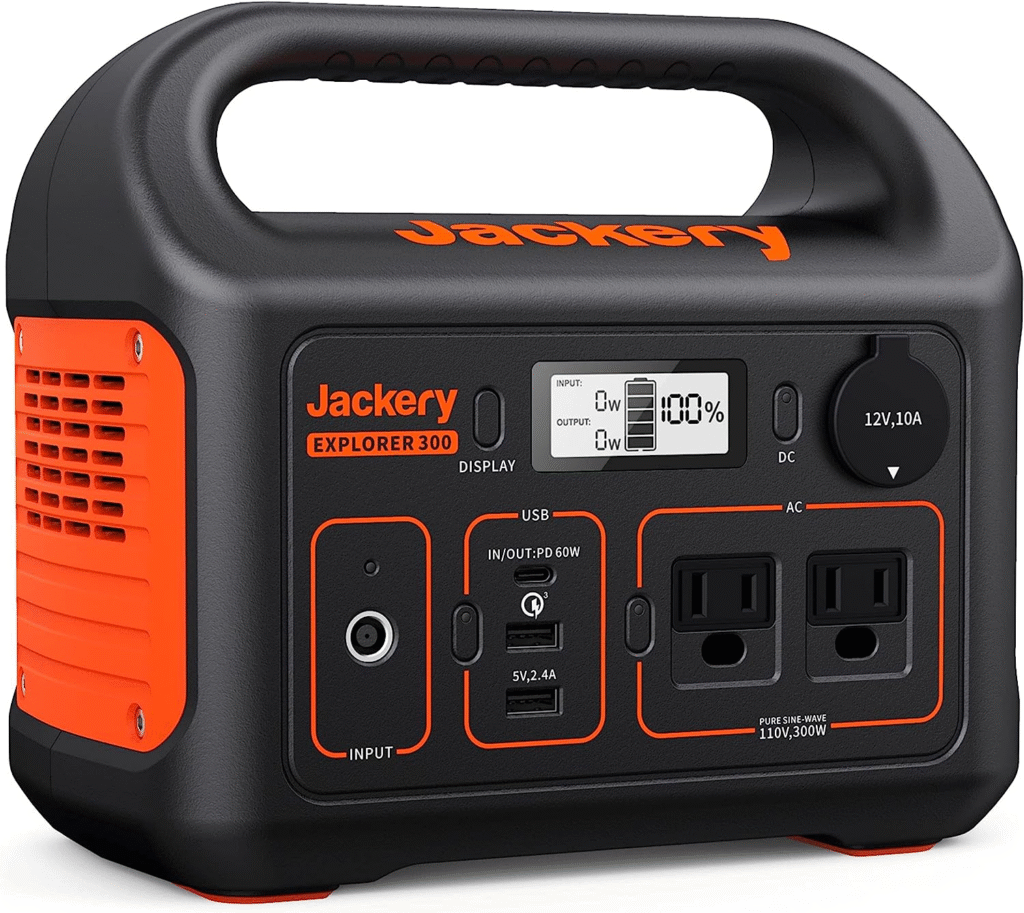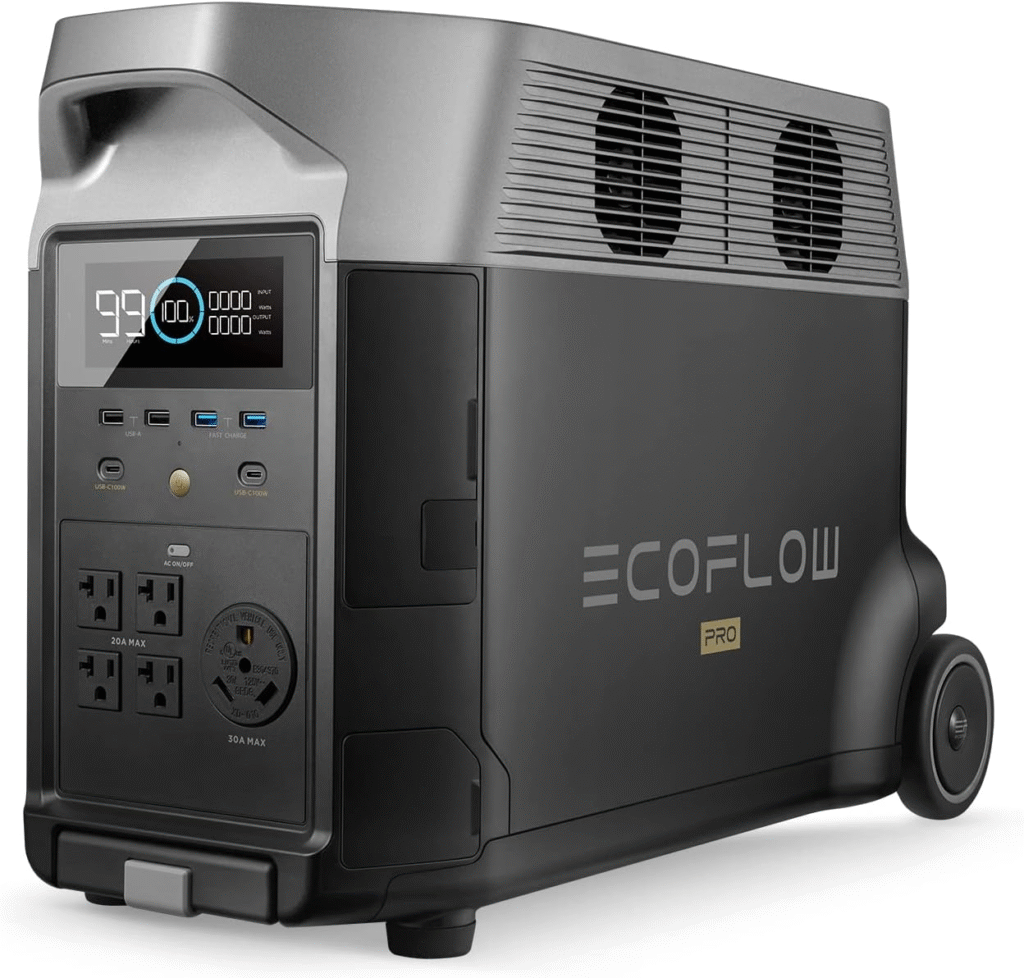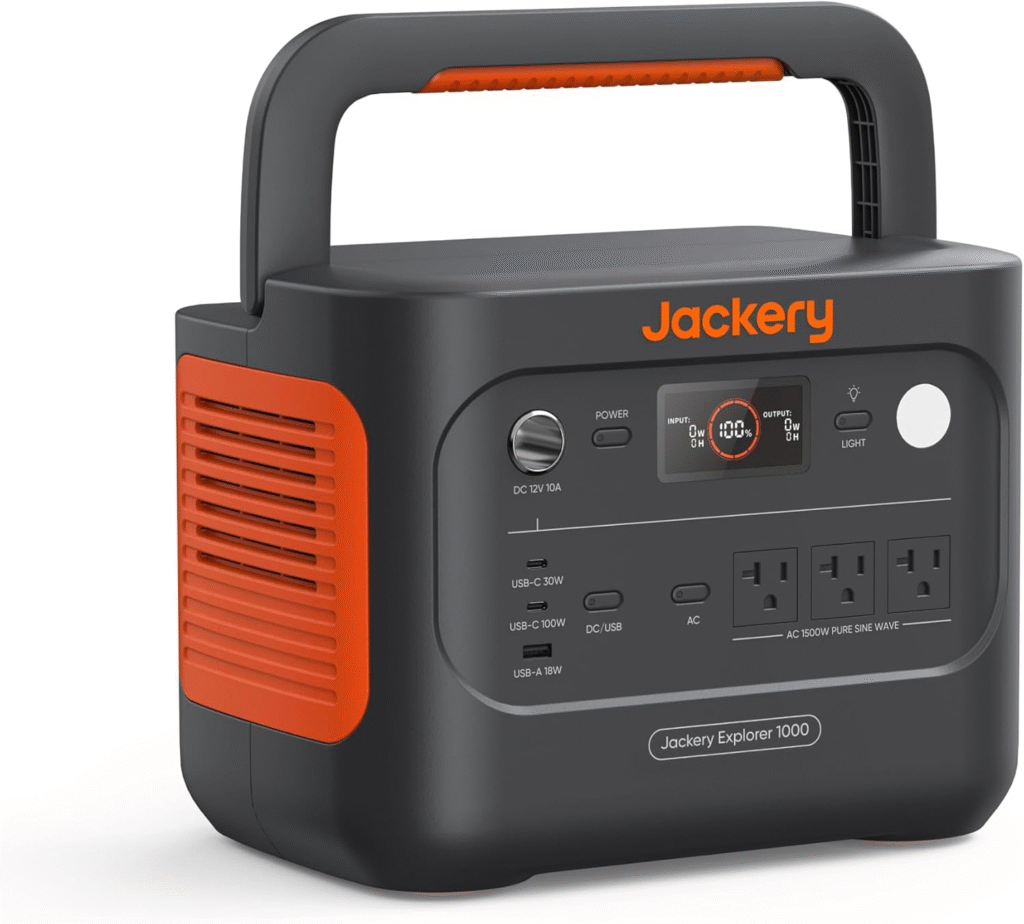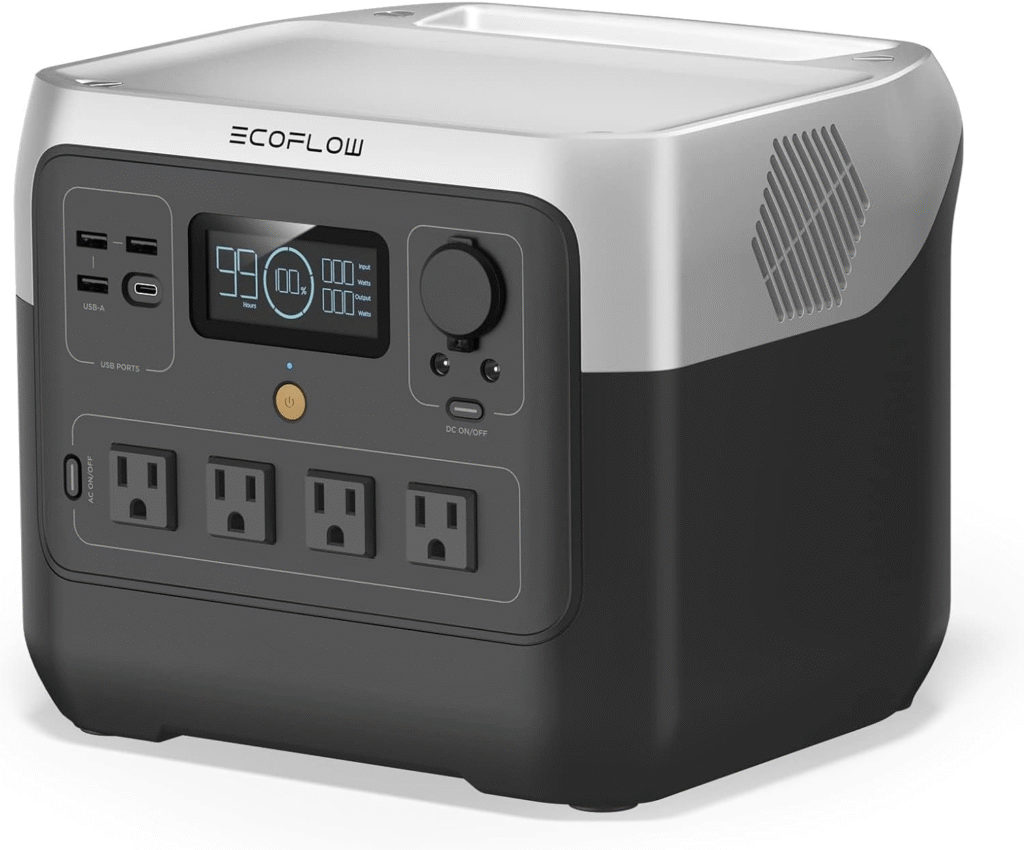Discover the best portable power stations of 2025 for camping, blackouts, and off-grid adventures. See our expert reviews on the top 5 models with fast charging and long-lasting batteries.
Are you still panicking when your devices die mid‑adventure? Discover the Best Portable Power Stations 2025 that will banish battery anxiety forever!
From backyard movie nights to off‑grid road trips, these compact powerhouses deliver reliable juice wherever you roam. Dive in and find the perfect sidekick for your gadgets—and your peace of mind!
Related: Best Solar Generators 2025
Best Portable Power Station Overall
EcoFlow DELTA Pro
The EcoFlow DELTA Pro reigns supreme as a mobile powerhouse, boasting a 3,600 Wh capacity expandable up to 25 kWh with extra batteries. Its robust 3,600 W continuous output (4,500 W peak with X-Boost) effortlessly runs heavy loads—from refrigerators to power tools. Crafted with LiFePO₄ cells, it endures 6,500 cycles to 50% capacity for true longevity.
Weighing in at ≈99 lbs and measuring 25″ × 11″ × 16″, the DELTA Pro’s luggage‑like design still rolls easily with optional wheels. Recharge times are stellar: 80% in 1 hour, full in 2 h 36 min via wall, rapid solar (up to 1,600 W XT60), EV charging, or even your car. Four AC outlets, two USB‑A, two USB‑C, car and DC ports—no device goes hungry.
With app monitoring and UPS ≤20 ms switch‑over, it’s a home‑backup boss as much as an adventure ally. Whether you need 51 hours for a fridge or 7 hours at 470 W, the DELTA Pro holds strong.
Reasons to Buy
- Galaxy‑class capacity
- Rapid recharge
- Expandable storage
- App‑driven control
Reasons to Avoid
- Hefty weight
- Premium price
- Bulky footprint
Recommended For
Homeowners and serious outdoor enthusiasts who demand an all‑in‑one, expandable power hub. Ideal if you need whole‑home backup, weekend off‑grid living, or tool‑grade output, and you’re okay with investing in the top‑tier model.
Best Portable Power Station for Camping
Anker SOLIX C1000
Engineered for rugged adventures, the Anker SOLIX C1000 packs 1,056 Wh of EV‑grade LiFePO₄ power into a 26.5 lb chassis (14.8″ × 8.07″ × 11.02″). With 1,800 W continuous (2,400 W surge) output across nine ports—four AC, two USB‑C (30 W/130 W), two USB‑A, and car/DC—it fuels everything from mini‑fridges to drills.
HyperFlash™ tech slashes full recharge to 58 minutes on a 1,300 W AC input and 80% in 43 minutes, so you’re never stranded. Smart app control lets you tweak recharge speeds, monitor wattage, and set schedules. Plus, it tolerates 3,000+ cycles to 80% capacity—a decade of dependable service.
With expandable 2 kWh battery packs and drop‑proof casing, the C1000 stands up to campsite knocks. A built‑in LED bar (three levels) keeps your tent lit—no headlamp needed.
Reasons to Buy
- Ultra‑fast charging
- Lightweight for its class
- App‑driven monitoring
Reasons to Avoid
- Mid‑range capacity
- No built‑in wheels
- Higher cost vs. peers
Recommended For
Campers and tailgaters seeking a nimble yet powerful station. If you crave rapid top‑ups and smartphone control, and you often power small appliances outdoors, the C1000 is your Swiss Army knife of juice.
Best Portable Power Station for On‑Site Work
Jackery Explorer 1000 V2
Jackery’s Explorer 1000 V2 upgrades to 1,070 Wh capacity and 1,500 W output (3,000 W surge), a 50% boost over its predecessor. In a 23.8 lb, foldable‑handle design, it balances heft with portability. Three AC outlets, USB‑A/C (up to 100 W PD), and a car port let you charge cameras, laptops, lights, and more simultaneously.
Emergency Charge Mode throttles from 0 to 100% in 1 hour via AC, while solar (up to 200 W) and car recharging offer flexibility. Next‑Gen ChargeShield 2.0 delivers 62 layers of protection, and LiFePO₄ cells ensure 4,000+ cycles for over a decade’s use.
Running a MacBook Pro at 100 W for 6 hours, or powering a fridge for hours, is effortless—perfect for job sites and remote work zones.
Reasons to Buy
- High power‑to‑weight
- Super‑fast recharge
- Long battery life
Reasons to Avoid
- Mid‑range capacity
- No app control
- Slightly pricey
Recommended For
Professionals needing reliable, rapid‑charge power for tools and devices. Ideal for contractors, event staff, or backyard DIY warriors who value speed and durability.
Best Portable Power Station for Road Trips
EcoFlow River 2 Pro
Hitting the sweet spot between capacity and weight, the EcoFlow River 2 Pro holds 768 Wh in LFP cells rated for 3,000 cycles. It delivers 800 W continuous, 1,600 W surge via X-Boost across three AC, three USB‑A, one USB‑C (100 W), car, and dual DC 5521 ports.
At only 17.2 lb (10.6″ × 10.2″ × 8.9″), it tucks neatly in car trunks. Four‑way charging—AC (940 W), solar (220 W), car, and USB‑C—reaches 0–100% in 70 minutes. A <30 ms EPS auto‑switch protects critical gear, while Wi‑Fi/Bluetooth app control keeps you in command.
Whether you’re streaming music at camp or powering a mini‑fridge en route, the River 2 Pro ensures limitless road‑trip fun.
Reasons to Buy
- Ultra‑light
- Fast multi‑mode charging
- Safety‑certified (TÜV)
Reasons to Avoid
- Modest capacity
- No expandability
- No wheels
Recommended For
Frequent road warriors craving compact power. If you road‑trip often and need quick, reliable juice for devices and small appliances, the River 2 Pro is your mobile pit crew.
Best Budget Portable Power Station

Jackery Explorer 300
For under $300, the Jackery Explorer 300 delivers 293 Wh and 300 W continuous (500 W surge) in a 7.1 lb, palm‑sized frame. Six ports—one AC, two USB‑A, one USB‑C PD (60 W), and car outlet—power phones, cameras, and mini fans easily.
Recharge to 80% in 2 hours via AC + USB‑C PD combo; full in 2.5 hours. Built‑in BMS safeguards devices, and pure sine wave output keeps sensitive electronics happy. At ≈36 dB, it’s whisper‑quiet for indoor or outdoor use.
It’s the go‑to for light travel or emergency stashes—pocketable power without breaking the bank.
Reasons to Buy
- Ultra‑lightweight
- Fast recharge
- Very affordable
Reasons to Avoid
- Low capacity
- Minimal ports
- No app control
Recommended For
Casual campers, commuters, and budget‑minded buyers who just need a quick charge for phones, tablets, and small gadgets. Ideal as a secondary emergency backup or weekend carry‑along.
Related: Portable Power Stations 2025
Frequently Asked Questions
- What’s the difference between LiFePO₄ and lithium‑ion batteries?
- Can I use solar panels to recharge any model?
- How do I maintain my power station for longevity?
- Is UPS functionality standard?
- Can these run heavy appliances?
- Are replacement batteries available?
Buying Guide: How to Choose the Best Portable Power Station
Selecting the perfect portable power station depends on capacity, output, port variety, charging flexibility, weight, and durability. First, estimate your power needs: sum the watt‑hour requirements of your devices (e.g., laptop 50 Wh/h × 6 h = 300 Wh). Add a margin (~20%) to cover inefficiencies. This total guides your minimum capacity choice: budget under 300 Wh for phones/tablets, 500–1,000 Wh for laptops and small appliances, and 3,000 Wh+ for whole‑home backup.
Next, examine continuous and surge output. Continuous watts determine what you can run simultaneously; surge handles startup loads (like refrigerators). If you plan to power tools or kitchen gear, aim for 1,500 W+ continuous. For simple camping use, 500–800 W suffices.
Ports matter—look for multiple AC outlets, USB‑A/C (PD), and DC/car sockets. USB‑C PD (60 W+) speeds laptop charging. Consider future gear: an e‑bike or CPAP machine may require specialized ports or adapters.
Recharge speed is crucial for on‑the‑go lifestyles. HyperFlash, X-Stream, or Emergency Charge modes can refill units in under an hour. Solar input ratings (e.g., 220 W vs. 600 W) dictate off‑grid performance—higher is better for fast solar top‑ups.
Weight and form factor balance capacity with portability. If backpacking, keep under 20 lb; for vehicle camping, 30–50 lb is manageable. Integrations like wheels, handles, or modular expandability (extra batteries) can tip the scales.
Battery chemistry influences lifespan and safety: LiFePO₄ (LFP) excels in cycle life and thermal stability, while NMC or lithium‑ion are lighter but degrade faster.
Finally, assess smart features—app control, UPS switching, safety certifications (TÜV, UL), and warranties. Premium models offer advanced monitoring and seamless home‑backup kits, while entry‑level units focus on simplicity and cost.
By aligning capacity, output, ports, recharge options, weight, and extras with your lifestyle, you’ll pinpoint the Best Portable Power Station 2025 for your adventures and emergencies.
Conclusion
Whether you need budget‑friendly trickle power or a full‑blown home backup, this line-up of the best portable power stations 2025 covers every scenario. From the juggernaut EcoFlow DELTA Pro to the nimble Jackery Explorer 300, choose the beast that fits your adventures—and never be tethered to a wall again!








